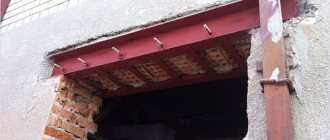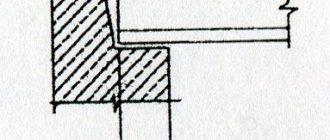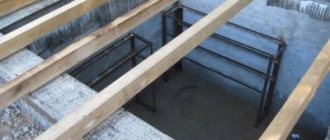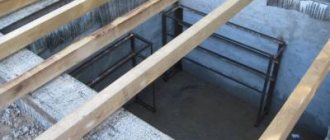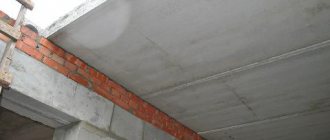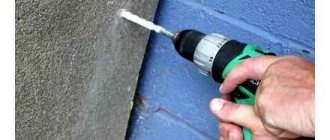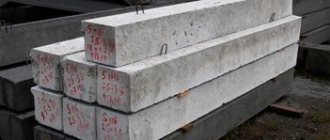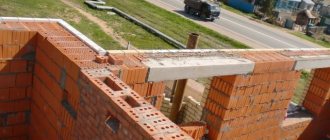Brick walls containing lintels evenly distribute the load on load-bearing surfaces, support the weight of higher floors (up to 2 tons) and prevent the building from collapsing.
Read more about the need to use jumpers in a brick wall, installation rules, regulations and other nuances in this article.
What it is?
Experts call a lintel a structural element involved in covering openings , which carries the bulk of the masonry and distributes the loads of materials (bricks, cement mortar, ceiling).
The lintels are in the form of reinforced concrete structures (RC), belonging to the factory series of type 1.038.1-1 or 1.225-2.
Instead, you can independently make monolithic reinforced lintels that correspond to the dimensions of the opening and the distributed load.
The difference between factory-made and self-made is that a finished product can cost more than a home-made one and has a quality mark. Regardless of the manufacturing method, it is customary to distinguish between the following types of jumpers:
Bearers. They have a beam type, with reinforcement, which is used to support floor slabs.- Non-load-bearing. Needed to distribute the load of the masonry.
- Runs. Available in very large sizes. Used for grandiose buildings.
- Pencils. Thin structures for doorways, with a partition thickness of 120 mm.
- Rigel. Made with a shelf, which is needed to support the structure located above.
The most common are the first two types of structures (load-bearing and non-load-bearing), carried out using technology, in accordance with established regulatory rules. For example, they are divided into block (PB) and slab (PP). Lintels help keep the laid bricks from moving and the wall from collapsing.
General characteristics
Products based on concrete and steel are widely used in private housing construction, due to their strength, durability and performance characteristics. The weight of the product depends on its dimensions.
Despite the weight, the finished product can be used in the construction of houses from:
- monolithic concrete;
- foam concrete;
- bricks
The supporting length for load-bearing lintels varies between 17-30 cm, for non-load-bearing lintels – 10-15 cm
SNiP and GOST standards
To regulate the rules for the manufacture, use and installation of jumpers, the following basic regulatory documentation is used, containing the entire list of necessary technical conditions:
- GOST R 57346-2016 Lintels for masonry.
- GOST 948-2016 Reinforced concrete lintels for brick buildings.
- SP 70.13330.2012 and SNiP 3.03.01-87 Load-bearing and enclosing structures.
- GOST 948-84 Reinforced concrete lintels for brick buildings.
- GOST 530-2007 “Ceramic brick and ceramic stone.”
- SNiP 12-04-2002 (section 9).
- SNiP 12-03-2001 Labor safety in construction.
- SNiP 3.03.01-1987 Load-bearing and enclosing structures.
In addition to the above, when constructing internal and external brick walls, the following rules are observed:
- OKS - all-Russian classifier of construction standards;
- KGS – classifier of state standards (Zh, Zh3, Zh33).
In accordance with the listed rules of technical documentation, it is necessary to carry out brickwork manually, without niches and cavities, and the elements should be placed in compliance with mandatory ligation, and the use of reinforced parts in places of increased load and openings.
The selection of the jumper should be carried out according to the width of the recess, the calculated load mass, in accordance with the digital designation on the product, if it is a factory type, as well as
the desired series, which includes:
- 038.1-1. “Ball lintels for residential and public buildings”;
- 038.1-1. “Reinforced concrete lintels. Issue 4";
- 038.1-1 “Reinforced concrete lintels for buildings with brick walls. Vol. 3.5-13".
SNiP II-22-81 “Stone and reinforced masonry structures” is also used when constructing lintels. These rules especially draw attention to the fact that reinforced concrete lintels must be arranged so that they take into account the load from the floors and freshly laid masonry (clause 6.47), which will be equal to 1/3 of the span in summer, and the whole span in winter work.
All rules must be strictly observed during the construction of brick buildings. Their implementation is monitored by specialists from the regional urban planning department.
Support indicator, characteristics
The concept of support represents methods of embedding . The support of lintels for brick walls is normally 25 cm in depth (should not be less). At the same time, above the door opening, its ends should touch the wall, at least 20 cm.
In this case, the supporting part will be reduced for a self-supporting wall to within 12 cm. The presented indicators are taken as the maximum and minimum depth of support.
Accounting for the support indicator must comply with the technical requirements of SNiP . The choice of the required jumper in depth is determined using the designation in the tables (example, 2PB18-8), indicating the overall dimensions:
- jumper-bar (PB - type of part);
- 2 – cross-sectional size 120 x 140 (mm) and strength class;
- 18 – product length (1810 – code), with two sides and maximum width – 1611 mm;
- 8 – permissible load (kg/m).
The designations of cross-sectional jumpers are as follows:
- 1 PB – 120 x 65 (mm);
- 2 PB - 120 x 140 (mm);
- 3 PB - 120 x 220 (mm);
- 4 PB - 120 x 290 (mm);
- 5 PB - 250 x 220 (mm).
Before installing jumpers, determining the depth of support is an important part of preparing for the work process. To do this, look at the indicators of the SNiP table and make a schematic template. According to the scheme, formwork is performed, and then the composition is poured on top of the laid structure.
Examples of overall dimensions can be found in the table:
The installation of lintels, in order to securely hold them, requires the laying of reinforcement at the contact of the reinforced concrete product and the brick wall.
Concrete lintels - purpose of products
In its main sections, the standard classifies products by type, contains information on the main parameters, technical requirements, and also regulates the dimensions of reinforced concrete lintels.
The high strength properties of crossbars reinforced with a reinforcing frame allow them to withstand bending loads in the openings of various buildings made from the following building materials:
- baked brick;
- natural stone;
- concrete blocks.
Purpose of reinforced concrete beams:
- compensation of existing loads;
- strengthening of various openings;
- formation of a supporting plane during the construction of walls;
- installation of jumpers over doors and windows.
The increased strength of reinforced concrete crossbars, due to the use of durable concrete, allows solving a wide range of problems in the construction industry.
When constructing buildings from piece materials (brick, cinder block, aerated concrete blocks), it becomes necessary to block door and window openings
Types of products
The lintels used for arranging brick walls are different:
- reinforced concrete,
- metal (made from channel and corners),
- brick,
- wooden,
- cellular prefabricated,
- reinforced brick.
Reinforced concrete
Reinforced concrete products are prefabricated and monolithic. Prefabricated ones include the following types:
bar (PB) of square or rectangular cross-section (maximum width – 250 mm, length – 1031-5960 mm);- slab (PP), two options in width (1 – 381 mm, 2 – 511 mm), height (141-221 mm) and length (maximum – 2981 mm);
- beam (PG), with a stepped section (a protruding flange for supporting the floor slab), width 250, 380, 510 mm, length - 1550-5950 mm.
There is also a facade type of lintel, but experts often classify it as PG, but with a slight difference - at the ends the shelf is made with recesses, and is clearly visible from the facade.
PP and PB are considered interchangeable . They have identical height and length, but differ only in width. This option is used if there are no slab-type lintels available at the construction site.
Monolithic lintels are installed in the wall itself using formwork. At the same time, they calculate the height of the structure (1/10-1/12 of the opening dimensions), with mandatory reinforcement (metal rods with a diameter of up to 12 mm).
The reinforcement is poured with a concrete composition with a thickness of at least 20 mm.
Metal
For such jumpers, rolled steel is used . They can make floors of 2-5 m, and they can be laid in both load-bearing and non-load-bearing parts. For brick walls, along with reinforced concrete products, this is one of the ideal options.
This product will withstand very heavy loads, as it is durable. Since such jumpers can be of any length, there are no questions when arranging openings of non-standard width.
Steel corners have a number range; numbers 10-12 are especially recommended .
Brick
They can be arranged in a straight line or curved (arch). The rectangular version is laid on the formwork, according to the rules for laying and tying bricks. Here you can create a wedge shape along the vertical seams of the masonry.
It is necessary to ensure that the seams are inclined and there is no vertical movement of the bricks. The work must take into account the width of the opening.
The curved lintel is laid using a wedge method, with emphasis on compression. Arched segments are obtained due to special laying with an edge, where the seams of the laid bricks open up.
The lifting booms are located in the range of 1/6 - 1/10 of the opening width. Curvilinear arches are laid out on a specially made circle - an arched device made of metal or plywood.
In practice, a metal circle for arches is more preferable, since its shape is easy to align or bend.
Wooden
This type of lintel is made from good quality boards, special plates and logs with edging and timber.
The ends of such structures are embedded into the wall, no less than 25 cm. Wooden lintels are easy to build with your own hands. They can last for many years (more than 50 years), but must be insulated from moisture penetration.
Therefore, when installing them, the products must be wrapped in insulating material (made of polypropylene, rubber, roofing felt, polyethylene). In modern construction, such floors are used less and less, despite their most affordable cost, since products made of reinforced concrete and metal are more durable.
Cellular prefabricated
Such products are made from cellular concrete , which can be reinforced and arched. The height of such a lintel is 125 mm, and the depth of its support is 200-250 mm. This type of lintel for brick walls is not yet very common.
Many experts believe that this material is more suitable for a wall built from the same cellular concrete.
Reinforced brick
They are made of brick and reinforcing metal components - hence their name. They are created according to the same principle as brick ones - straight or arched.
The reinforcement used in their arrangement is 6-10 mm. It is laid in formwork, filled with concrete solution. This protects them from corrosion.
There is another way of laying this type - in the form of a collapse vault. Only a professional can perform this method.
Each of the listed types of jumpers is good in its own way . Which one is suitable in each specific case depends on the time of construction (renovation of an old building, new building), additional materials used, in addition to bricks, the existing plan and structure diagram (drawing), the wishes of the customer and the material component.
How to make a jumper yourself
Sequencing:
- Creating a sketch of the bar and shape.
- Polyethylene is placed in the finished form. This material has a smooth surface, is not a porous coating, and therefore is easily separated from the concrete during the extraction process.
- Rods are prepared (diameter 10-12 mm), the length is determined by the dimensions of the beam.
- A frame is created from reinforcement: you need to make a lattice of 4 longitudinal rods, they are connected with wire.
- The metal structure is installed in the finished form, but it must be placed on pads from below, which will ensure the same distance from the frame to the top and bottom edges of the beam.
- A solution is prepared (the ratio of components is standard).
- The form is filled with concrete.
- The top of the structure is covered with polyethylene.
- The concrete is periodically moistened.
It will take 1 month to harden, after which the product can be removed from the mold.
Laying formwork, reinforcement
The molding structure performs the function of formwork. Boards are prepared for this. If you plan to fill at height, it is better to use metal, but it is acceptable to use plywood, wood and particle boards. The structure must be strengthened. For this reason, you need to create a mold with walls at least 20 mm thick.
Nails are used to secure wood; the metal is secured with self-tapping screws. When the formwork is created in weight, the lower shield is first installed (it extends beyond the opening); horizontal - supported by supports.
To reduce heat loss from the room, it is recommended to insulate the lintel. Mineral wool, expanded polystyrene or polystyrene are considered as thermal insulation materials. Recommended thickness is 100 mm.
Pouring concrete
To prepare the solution, use concrete M200 or M250. The proportions of crushed stone, sand, cement are 2:5:1. It is better to mix the components in a concrete mixer. This creates an even mixture. When mixed independently, the solution is compacted to eliminate air. When the reinforcement frame is installed on the bottom of the formwork (on supports up to 200 mm high), the container is filled with mortar.
How to choose?
It is better to leave the selection of a suitable jumper to professionals. They will evaluate the type of wall, the features of the construction, and the characteristics of the constituent elements that will need to be laid in one direction to achieve the desired span width.
When choosing, take into account the amount of load that the jumper will have to withstand and the quality of the material. So, for example, if the lintel is concrete, then the grade of concrete is taken into account. The same applies to bricks and reinforcement (steel grade).
They also pay attention to the design boundaries, the application of SNiP standards (depth of support), and the parameters of finished products specified by manufacturers. Especially pay attention to the bends of the material. For example, metal supports should normally bend no more than 1/200 of their specified length.
An example of the correct selection of a jumper (in this case, metal) can be seen below:
Calculation example
The correct calculation of the lintel for the opening is made using an exact or simplified calculation. To avoid mistakes, you need to use indicators from the SNiP tables .
Simplified
Here it is customary to first determine the load acting on the lintel, then determine the maximum bending moment acting on the cross section.
Loads per linear meter are determined depending on the weight of the masonry: q1 = p x b x h , where:
- p in kg/m3 - the density of the material from which the partition is made (this also includes the masonry mortar),
- b – wall thickness,
- h – masonry height.
For example, if the intended opening for a brick partition is 1 m wide and the thickness is ½ of a brick product, then its total design load will be: q = 1.1 x 142.5 = 157 (kg/m).
When determining design operations for lintels in brick walls, pay attention to masonry in summer or winter, which is indicated by SNiP “Stone and reinforced masonry structures” in its clause 6.47.
Reinforced concrete prefabricated lintels
Prefabricated reinforced concrete lintels are quite common in stone houses, since they require the least amount of labor and time to install such lintels.
There are offers on the market for jumpers of different sizes and sections. Given the variety of wall masonry materials, this makes precast concrete lintels an attractive option. However, prefabricated lintels impose restrictions on the imagination of the shapes of the openings: they can only be rectilinear. Reinforced concrete prefabricated lintels are divided into types:
- PB - timber (lintel width 120 and 250 mm);
- PP - slab (lintel width more than 250 mm);
- PG—beam.
In the practice of low-rise private housing construction, block lintels are most often used; slabs and beams are in little demand. This is partly due to the significant mass of these jumpers, partly due to the limited sales market.
Types of reinforced concrete prefabricated lintels: a - block PB; b - slab PP; c - beam, with a quarter; 1 - timber non-load-bearing PB; 2 - beam-bearing PB; 3 - slab PP; 4 - beam, with a quarter of the PG; 5 - floor slab resting on the wall; 6 - floor slab adjacent to the wall.
Bar lintels are selected for a unified load:
- non-load-bearing - 100, 200, 300, 400 and 800 kN/m (kgf/m); this load consists of the mass of the masonry above the lintel and the mass of the roof structure, and also depends on the width of the opening;
- load-bearing - for loads of 2000, 2700, 3700 and 5200 kN/m; The load from the floor, including temporary, is added to the load listed above.
Please remember. Strengthening the lintel cannot be achieved if one lintel is placed on top of another - they will not work as a single unit, and, therefore, the load-bearing capacity of these two lintels will still be less than one lintel, the cross-sectional height of which is equal to the total height of these two lintels.
The parameters of the lintels are also unified: width - 120 and 250 mm, height 65, 90, 140 mm (as a rule, these are non-load-bearing lintels), 220 and 290 mm (load-bearing), length - from 1030 to 3890 mm with gradations of 260 and 130 mm, further - the length of the jumpers is 4410, 4800 and 5960 mm. As you can see, the length parameters of the lintels are in good agreement with the dimensions of the brick. Some timber lintels are shown in the table.
| Marking | DxV with lintel width 120 mm | Marking | DxV with lintel width 120 mm | Marking | DxV with lintel width 250 mm | Marking | DxV with lintel width 250 mm |
| PB-10-1 | 1030×65/90/140 | PB-26-4 | 2590×140/190 | PB-44-8 | 4410×290 | PB-31-27 | 3110×220 |
| PB-13-1 | 1290×65/90/140 | PB-29-4 | 2850×140/190 | PB-60-8 | 5960×290 | PB-27-37 | 2720×190/220 |
| PB-16-2 | 1550×90/140 | PB-21-8 | 2070×190/220 | PB-34-20 | 3370×220 | PB-13-37 | 1290×190/220 |
| PB-17-2 | 1680×90/140 | PB-25-8 | 2460×190/220 | PB-36-20 | 3630×220 | PB-18-37 | 1810×190/220 |
| PB-25-3 | 2460×90/140 | PB-30-8 | 2980×190/220 | PB-18-27 | 1810×190/220 | PB-35-37 | 3500×290 |
| PB-19-3 | 1940×90/140 | PB-39-8 | 3890×220 | PB-27-27 | 2720×190/220 | PB-60-52 | 5950×585 |
The length of the lintels is selected based on the condition of their support on the walls: non-load-bearing lintels extend into the walls by at least 120 mm, and load-bearing lintels by at least 150...200 mm. If the walls are made of brick, then the load-bearing lintel is selected based on the support of 250 mm (per the length of the brick), so that there is no knocking of the masonry.
Bar lintels are used both in brick and ceramic stone walls, and in small-block houses.
If the construction area is in a warm climate zone or the wall is insulated in such a way that the insulation covers the lintels, then no measures are taken in installing the lintels, laying them with a continuous tape. In cold areas, measures must be taken to avoid the formation of cold bridges that will penetrate through a continuous series of bridges. Here's the thing. We remember that reinforced concrete, compared to brick, has a much higher thermal conductivity coefficient. Therefore, even if, according to the thermal characteristics, solid brickwork is sufficient, then for reinforced concrete lintels with the same general cross-section, the thermal protection may not be enough - a cold bridge arises. The same applies to walls that are made of cellular concrete and ceramic stone.
To prevent this from happening, thermal connectors are installed between the reinforced concrete jumpers, replacing one of the jumpers with insulation. The load-bearing capacity of the lintels does not suffer - reinforced concrete has a fairly high strength. The figure shows a wall made of porous ceramic stone, the thickness of which meets the heat protection requirements. However, in the place where the floor slab rests, the thermal characteristics are deteriorated, so insulation is laid here. A layer of insulation is also placed in the jumper strip.
The same situation is possible in walls made of cellular blocks - insulation may also be needed here. In this case, the insulation can be laid staggered. Please note that in the places where the slab rests, a non-flammable insulation is laid - a fire-resistant cut.
The insulation in the thermal connectors is placed immediately before installing the window units, and since it holds well due to friction forces, it does not need to be supported by anything.
On the outside of the outer wall, it is advisable to protect the window block from external atmospheric influences: freezing and blowing. For this purpose, the opening is arranged “with a quarter”: the outer lintel is laid 65 mm lower than the rest. This parameter was not chosen by chance: the height of the brick row is 65 mm, i.e. a quarter of a brick, hence the name - “opening with a quarter”. To create a quarter and make it easier to lay out the blocks, a lintel with a larger cross-section than a non-load-bearing one can be placed above the opening. In this case, the name “quarter” remains, but the size can be more than 65 mm.
If the quarter is formed by insulation, then its overhanging part is supported by a metal element, usually a corner.
The quarter is placed not only at the top of the opening, but also outside its side part. The picture shows a horizontal section of the opening, showing how the brickwork forms a quarter. The design is shown in more detail in the figure (the material of the load-bearing part of the wall is shown conditionally). It also shows how the load-bearing and finishing layers are connected using steel mesh or embedded loops.
Slab lintels can withstand greater loads than timber lintels and, therefore, are more often used in load-bearing walls. Slab lintels are produced in shorter lengths than block lintels - the longest length is 3 m.
| Marking | DxV with lintel width 380 mm | Marking | DxV with lintel width 380 mm | Marking | DxV with lintel width 510 mm | Marking | DxV with lintel width 510 mm |
| PP-12-3 | 1160×65/90 | PP-21-6 | 2070×140/190 | PP-14-3 | 1420×190/220 | PP-17-6 | 1680×90/140 |
| PP-14-4 | 1420×140/90 | PP-23-7 | 2330×140/190 | PP-12-4 | 1160×65/90 | PP-23-10 | 2330×140/190 |
| PP-18-5 | 1810×140/190 | PP-25-8 | 2460×140/190 | PP-14-5 | 1420×90/140 | PP-30-13 | 2980×220 |
Plan of a window opening with quarters: a - brickwork with quarters of an uninsulated wall; b- location of the window block in the opening; c - formation of a quarter in an insulated wall, lined with brick; d - opening node showing the connection of layers using meshes; d - the same, using loops; 1 - quarter; 2 - window block; 3 - load-bearing part of the wall (reinforced concrete, brick, blocks); 4 — adhesive composition for gluing thermal insulation boards; 5 — polystyrene foam insulation; 6 - straightening gap (sand backfill); 7— protective and decorative masonry; 8—fire-resistant cut made of mineral wool slabs; 9- dowel; 10— construction foam; II - internal plaster; 12- dowel; 13 - nail d=6 mm through a wooden spacer with a pitch of 600 mm, but not less than 2 pcs. on the opening; 14 — embedded mesh; 15 — reinforcement bars d=6 mm; 16 — knitting wire; 17-embedded loop
Beam lintels play the role of a beam, so it is advisable to use them in a frame structural system. If they are used in a wall system, then, of course, they are laid in a load-bearing wall. The shortest lintel is 1.5 m, the longest is 6 m (rounded). Some of the beam lintels are shown in the table.
| Marking | DxV with lintel width 250 mm | Marking | DxV with lintel width 250 mm | Marking | DxV with lintel width 380 mm | Marking | DxV with lintel width 380 mm |
| PG-44-8 | 4410×290 | PG-39-31 | 3890×440 | PG-35-17 | 3500×290 | PG-35-37 | 3500×290 |
| PG-48-8 | 4800×290 | PG-48-31 | 4800×440 | PG-60-31 | 5960×440 | PG-44-40 | 4410×440 |
As already mentioned, slab and beam lintels are rarely used in low-rise construction. There are many different reasons for this. Firstly, their sales market is not as widespread as bar lintels. Secondly, the mass of slab and beam lintels is large and requires the delivery and installation of appropriate equipment, which is not always available to the customer in terms of price and the ability to place it on the construction site. Thirdly, such jumpers do not allow making thermal connectors if this is necessary due to climatic conditions. However, if the walls have a layered structure in which external insulation is provided, then this reason is not an obstacle to their use.
Materials and tools for the device
To install lintels in brick walls, you will need the following consumables and tools:
construction hammer, hacksaw, electric drill, screwdriver;- set of installation accessories;
- trowel, putty, brushes, spatulas, bucket for mortar;
- edged boards of the same thickness, with metal or wooden supports;
- metal corners, self-tapping screws, reinforcing mesh or metal rods, nails with wide heads, binding wire;
- polyethylene film, roofing felt;
- composition for concrete in finished form or separately: cement, sand, gravel, water, slag.
Separately, gloves, overalls, rags, brushes and “levelers” for concrete may be useful so that the poured solution is well compacted when distributed, filling the pores of the wall and formwork attached to the surface.
Reinforced brick lintels
Rectangular openings with a brick lintel can be widened by placing reinforcement under the masonry above the opening. These are ordinary jumpers. Take reinforcement with a diameter of 6 ... 10 mm or strip steel, lay it over the opening along the formwork, one or two rods per half-brick section of the wall. The ends of the reinforcement are inserted into the walls at 300...500 mm. Then they are filled with cement mortar with a layer thickness of 30...40 mm, which protects the reinforcement from corrosion.
The device diagrams were circled for laying out curved brick arches: a - for flat segmental arches with a lifting boom of less than 200 mm; b - blank from knocked down boards for ascending arches; c - sawing off the ends of the boards to form a curved circle line; 1 - thin plywood, which can be bent; 2 - boards; 3 - boards with sawn ends.
Construction of an ordinary lintel: a - in a non-load-bearing wall; b— in a load-bearing wall; 1 - cement mortar; 2- reinforcement d = 6... 10 mm (or strip steel); 3 - ordinary jumper; 4 - beam-bearing lintel.
An ordinary lintel is practically invisible on the facade, so they resort to its help if they do not want to lay out a wedge lintel. However, ordinary lintels cannot support the load from the ceiling, so they are laid in a non-load-bearing wall with an opening up to 1.2 m wide and in partitions. If it comes to a load-bearing wall, then ordinary lintels are mounted only under the outer layer of brick so that they are not visible on the facade, and the load-bearing part of the wall is supported by prefabricated or monolithic reinforced concrete lintels.
There is another way to reinforce the brickwork of a rectangular lintel. To understand the essence, let's look at the diagram shown in the figure. There is such a thing as a collapse vault - this is the volume of masonry above the opening that can collapse if its load-bearing capacity is exceeded. The approximate height of the collapse arch can be determined by two rays emerging at an angle of 45° from the extreme points of the opening. If this section is supported by vertical reinforcement, then collapse will not occur. This method is called the hanging method.
Reinforcement of a brick lintel: a - one collapse vault; b - two collapse vaults; 1 - shape of the collapse vault; 2- approximate shape of the collapse vault; 3 - twist; 4 - annealed wire reinforcement d = 6...8 mm; 5 - reinforcing bars d = 6... 10 mm; 6 - bent end of the reinforcing bar; 7- piece of reinforcement.
The hanging technology is as follows. Brickwork is laid on the formwork with a height slightly higher than the collapse arch. So, for an opening 1 m wide, the height of the collapse arch will be approximately 0.5 m. Reinforcing bars with a diameter of 6 ... 10 mm are laid on top of this masonry, which are pinched with a refuge fine into the piers by at least 500 mm. After the solution gains strength, a vertical hole is made in the masonry at the place of suspension (with a hammer drill), into which a suspension is placed - vertical reinforcement with a diameter of 6...8 mm made of annealed wire (the wire is placed in the fire and heated until red, then cooled in air; after these actions the wire becomes plastic). The suspension is secured at the bottom with a loop with a stop made of a piece of reinforcement, and at the top it is pulled onto the horizontal reinforcement using twisting. The suspension can be tensioned from above using a jack, and then welded to the horizontal reinforcement.
To reduce the height of the reinforcement, it is necessary to reduce the height of the collapse arch. To do this, the opening is divided into several sections, for each of which its own collapse vault is built, then each section is reinforced in the described way.
This method can be used to install lintels in both non-load-bearing and load-bearing walls. However, in a load-bearing wall the situation is more complicated - in the design of the lintel the load from the floor must be taken into account.
Process
The arrangement of lintels, with the formation of a unit and taking into account support in the wall, must take place according to the rules described in SNiPs. Since reinforced concrete lintels are used most often in modern buildings, the process of their installation consists of the following nuances:
- For laying, a ledge is made with a width of at least 25 cm, and on each side of the opening, the length of the structure should exceed this width by 50 cm.
- For installation, use a truck crane to lift the lintel - it will lift and lower it to the desired support point, onto which uncured concrete mortar has already been applied.
- With prefabricated options, formwork is arranged, formed along the width of the opening, a reinforcement cage is knitted and the lintels are poured in a monolithic manner, leaving them until completely dry.
Metal jumpers are lightweight. Presented in the form of channels and various forms of rolled steel, their advantage is that during operation they can be cut to the required length.
This option is also suitable when other types of lintels are categorically unsuitable for the wall of a particular opening, or a new one made from other materials cannot be installed (the old opening is expanded or a new one is cut out). Metal can bend, so supports are made to support them. In the rest of the process: concrete is poured, as with reinforced concrete.
Brick lintels are mounted to the main wall along the top of the opening , and then connected to each other using a shelf from which clamps hang, placed in vertical seams. The clamps reliably reinforce the lintel, and it turns out strong.
Experienced craftsmen choose longitudinal, wedge, beam or vaulted installation methods. Concrete mortar for laying is mixed in small portions so that it does not harden quickly.
Recently, in most cases, builders have placed the professional BAUT reinforcement system into brick lintels.
A simple and reliable way to install a brick lintel - in the video:
Tips and secrets
Recommendations for performing installation work:
- beams are selected taking into account the size of the opening, their height corresponds to 5% of the height of the window or door;
- the diameter of the frame rod is selected taking into account the intensity of the load, it can vary between 10-14 mm; for the construction of low-rise buildings, the average value is used; to strengthen internal openings, the thinnest reinforcement is used;
- you cannot use beams that correspond to the width of the opening or slightly overlap it; the margin along the length of the lintel must be significant; they often create a concrete belt around the perimeter of the object;
- it is impossible to continue work until the cement has completely hardened, vibrations, constant damage to hardening products - these negative factors will contribute to a decrease in the quality of the finished beams;
- It is important to install the supports correctly; several pieces are used, since concrete creates a load of more than 2 tons per 1 m³.
The welding method should not be used when installing the reinforcement cage. This may cause a reduction in the service life of the structure. If beams are made when air humidity levels are high, there is no need to additionally wet them.
Products are sprayed with water in the summer when the heat is intense. Starting work before the concrete in the formwork has dried will lead to the loss of properties of the material.
Consequences of errors
To avoid problems in the form of consequences during the construction process, it is better to entrust the selection of lintels to a professional construction engineer.
Based on an examination of the load-bearing capacity of the wall, the depth of support, and a number of mandatory characteristics, he will carry out the necessary calculations and determine exactly what material, shape and size the lintel will be suitable for in this particular case (length, width, thickness).
The consequences of errors are destruction, cracks, and displacement of bricks. To prevent them from arising, you must observe the following nuances:
lintels must comply with the design, taking into account their load-bearing capacity;- it is not advisable to use materials or their remains that are at hand to create structures in the form of lintels;
- it is necessary to reinforce the opening or recess in the wall;
- It is necessary to make cement mortar, taking into account the class of concrete;
- on the surface on which the structure is laid there should be no chips, cracks, or exposed reinforcement;
- it is necessary to take into account the fulcrum (norm 15-25 cm);
- the length of support should be evenly distributed on both sides of the opening, indicating the midpoint (central node);
- products that are involved in the arrangement of the lintel must be marked and classed.
Work on arranging openings must be carried out with the preparation of a Hidden Work Report. It must be accompanied by a quality certificate for each product used. It is necessary to properly prepare the walls for installation, since the health, safety and lives of the people who will live in the house depend on their arrangement.
Features of the beam device
Reinforced concrete lintels according to GOST 948-2016 include:
- spatial frame made of steel reinforcement, increasing rigidity and strength characteristics;
- branded concrete, the frost resistance of which is regulated by the standard for various climatic conditions;
- sling eyes or holes that facilitate the transportation and lifting of products with increased weight.
The products can be used in harsh climates with outside air temperatures of 40 degrees Celsius below zero. If it is necessary to manufacture beams intended for use in seismically active areas, the technical requirements are specified in the order. It must comply with the design documentation for the building. Products for use in aggressive conditions are also manufactured according to individual customer requirements.
Manufacturing technology
In the production process of products, heavy concrete is used, class above B15, the density of which can vary from 2200 to 2500 kg/m3. To strengthen products and increase their load-bearing capacity, resistance to tensile and bending forces, reinforcement technology is used. The frame is made from hot-rolled steel rods in accordance with GOST 5781-82 with an anti-corrosion coating with a diameter of 4-6 mm. Both prestressed and non-prestressed steel reinforcement products are used in the production process.
The following types of reinforcing steel are used in the form of prestressed longitudinal reinforcement for lintels:
- hot-rolled rods A600 and A800 in accordance with GOST 5781;
- thermally strengthened reinforcement belonging to the At600S and At800 classes in accordance with GOST 10884 regulations.
When using non-prestressing reinforcement, steel such as:
- rods of classes At500S and At400S with thermal hardening according to the requirements of GOST 10884;
- steel reinforcement A500 and A400 according to the requirements of GOST 5781 standards;
- reinforcing wire belonging to classes BP500 and B500 according to GOST 6727.
As transverse reinforcement, steel rods of classes A240, A500 and A400 are used in accordance with the regulations of the industry standard GOST 5781, as well as reinforcing wire of classes B500, BP500 in accordance with GOST 6727. Non-stressed reinforcement is tensioned mechanically or electromechanically using special stops.
In addition, to increase crack resistance, products must be reinforced using meshes. To avoid destruction of the reinforcing lattice, the concrete coating must hide the steel lattice and its parts. The thickness of the protective layer must be at least 20 mm. The presence of protruding parts of reinforcement in finished products is not allowed.
In the production of building elements, manufacturing plants use special forms, inside of which pre-prepared reinforcement frames and meshes are placed. After this, the form is filled with concrete mortar, which is compacted by vibrohydropressing. As a result of the creation of vibration, air bubbles and layers are excluded from the solution, which cause a point reduction in the strength of reinforced concrete products and a reduction in their service life. Products can be dried either naturally or in steaming chambers, which allow the process to be accelerated over time. The percentage strength of the concrete solution in the manufacture of lintels should be:
- 70% - in warm weather;
- 90% - in winter.
The load-bearing capacity of each lintel is determined by the class of reinforcement used, the class and type of concrete mortar used in the production.
Rolled steel lintels
An alternative to precast concrete lintels are rolled steel lintels. They allow you to cover openings with a width of 2 to 5 meters, and can be laid in a load-bearing or non-load-bearing wall. At the same time, the wall material is any small-sized: brick, small blocks, ceramic stone. Lintels made of rolled steel are not heavy, they can be delivered to a construction site without the use of lifting and transport mechanisms, unlike reinforced concrete products. Also, the advantages of lintels made of rolled steel include the fact that they can be of any length, and, therefore, the issue of openings of non-standard width is easily resolved. In addition, such lintels are selected for any section of the masonry wall.
Schemes for installing lintels made of rolled steel: 1 - brickwork; 2- corners.
Corners are most convenient as jumpers. For example, corners No. 10-12 are suitable for a 1.5-meter opening. Based on the idea shown in the figure, it is not at all difficult to develop design solutions for other sections or wall materials.
Lintels made of rolled steel are durable, but their durability is lower than reinforced concrete lintels. Another question is that if the technology for laying steel lintels is violated, cold bridges can form, since the thermal conductivity coefficient of steel is quite high.

